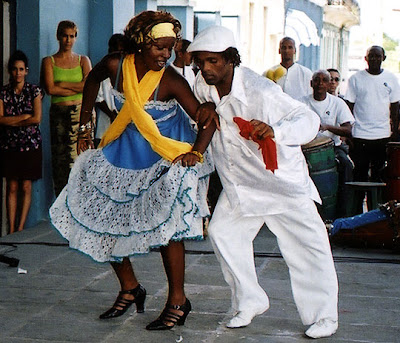
The father and uncle Pedro López (Manley's father) ran in the 1940 an orchestra of his (Pop), who played for the holiday calendar. At the end of their performance, we played the Rumba, music hybrid of Afro-Cuban popular music. The "Peñas " (festivals) rumba Lopez family became famous throughout Havana, soon attracting renowned musicians such as "Los Aspirina " (most famous family rumberos Havana), the Borough neighbor Guanabacoa , or Juan Ramos de Dios "El Colo" or Maximino Duquesne Francis.

Family "Aspirina" is also known for being close to the legendary Pablo Roche Cañal " Akilakuá "the greatest player of Cuba batá of all time. Mario Jáuregui Aspirina is a rare student of Pablo Roche still alive. Despite the changing style of play batá, Pedro (disappeared) and Mario Aspirina are recognized as the guardians of the old style of Pablo Roche.
Ce sont eux, qui, prenant les frères López sous leur aile, leur ont enseigné les tambours sacrés du culte yoruba de Cuba, dits: " tambours Batá ".
Ils ont permis aux Chinitos d'intégrer leur célèbre orchestre de rumba: Aspirina Guaguancó .
Tout en étant considérée dans le monde de la musique afro-cubaine comme la plus inovatrice des familles de musiciens de tout Cuba dans les vingt dernières années, la famille López a collaboré avec les plus authentiques et les plus anciens musiciens de La Havane.
Le père et les Oncles de Manley:
 Pedro Lopez is the father of Manley. He worked as a carpenter with the man who according to him would have invented the first cajon "pyramid" of Cuba: Ifraín Friol Kofa. He was recently contacted to join a project bringing together musicians famous rumba, similar to the "Buena Vista Social Club".
Pedro Lopez is the father of Manley. He worked as a carpenter with the man who according to him would have invented the first cajon "pyramid" of Cuba: Ifraín Friol Kofa. He was recently contacted to join a project bringing together musicians famous rumba, similar to the "Buena Vista Social Club".
 "Bertico" Lopez is also a percussionist, and he joined the famous band rumba " Grupo Yoruba Andabo ", formerly (since 1961) " Guaguancó Maritimo Portuario . He has led the Guarapachangueo within the group, and influenced the famous Pancho Quinto Mora, one of the greatest drummers of Cuba, who died last year.
"Bertico" Lopez is also a percussionist, and he joined the famous band rumba " Grupo Yoruba Andabo ", formerly (since 1961) " Guaguancó Maritimo Portuario . He has led the Guarapachangueo within the group, and influenced the famous Pancho Quinto Mora, one of the greatest drummers of Cuba, who died last year.
 Irian López, Manley's uncle, was a member of the prestigious Conjunto Foklórico Nacional de Cuba, gathering the best specialists of the island in the 1980s. It appears in the film "El País de los orisha.
Irian López, Manley's uncle, was a member of the prestigious Conjunto Foklórico Nacional de Cuba, gathering the best specialists of the island in the 1980s. It appears in the film "El País de los orisha.
 Reynaldo is the fourth brother of the family. He is a percussionist and singer. His repertoire is endless rumba.
Reynaldo is the fourth brother of the family. He is a percussionist and singer. His repertoire is endless rumba.
During the 1970s, have Chinitos invented a style of rumba called " Guarapachangueo "
(or as they call themselves, "Guarapachanguero") who created a revolution in the world of the Rumba. The "modern" style of bands like:
"Conjunto de Clave y Guaguancó " or
" Grupo Yoruba Andabo " is derived from elements borrowed Chinitos.
Rumba is a secular event, where everyone can express their feelings by singing. It induces a permanent exchange between the singer and the people present who answered him in chorus.
instruments that are exclusively percussion music, using rhythms and phrases highly syncopated. He is then to accompany songs, but also dances. The song is dominant until the appearance of the refrain, or "estribillo", from which the dominant element becomes the dance.

Three main rhythms are used, featuring various styles of song and dance: the
Yambú the Columbia and the popular Guaguancó .
Rumba was born together in ports
(Havana, Matanzas and Cárdenas) and country (Sabanilla, Matanzas province, which would have appeared at Columbia).
Rumba is now practiced throughout Cuba, both the city and countryside, and an integral part of Cuban culture.
The drums used are the source of cajones (wooden drums), then congas. The "Chinitos" invented their own type of "cajon", created by Pedro, adapted to the style "Rumba Guarapachanguero.

López
The four brothers started playing the drums Bata in the 1980s and now have their own set of dedicated
drums (or drum fundamento "), named" Aña Obba Tola "which is now recognized as among the most prestigious of Havana.
Manley was born in this environment bubbling, and has always shown great interest in music. He studied from an early age with his uncle Irian. Now is the new solo family, and he is quoted in Havana as part of the "talented youth" World Folk Afro-Cuban.
0 comments:
Post a Comment